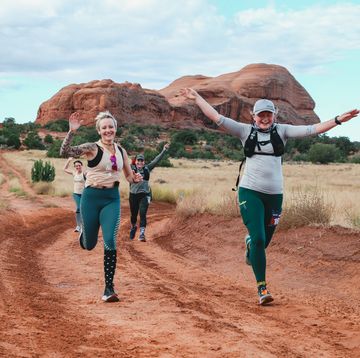Most runners log their miles on neighborhood streets. But roads shouldn't be your only training ground. "Running on different surfaces changes up the scenery, workout, and effort, giving road runners an often-needed break," says Jennifer Novak, a running and multisport coach at Kona Fitness in New Orleans. A change of venue can also keep you healthier and boost your fitness. Running once or twice a week on grass, sand, or trails, or even in the pool, reduces pounding on your legs, which minimizes injury risk. And pushing off on softer surfaces engages and strengthens more muscles, which can translate into faster times on the road, says Novak. Here's how to adapt your workout to whatever lies beneath.
GRASS
Compared with asphalt or concrete, running on grass produces up to 17 percent less pressure on your feet, reports a recent study in the Journal of Sports Sciences. This makes it ideal for runners on the mend who want a forgiving surface to help them transition back to the roads, says Eric Blake, head track-and-field and cross-country coach at Central Connecticut State University. That giving nature is also ideal for runners looking to minimize injury risk while increasing mileage or intensity.
What to do there: Speedwork. On a well-groomed surface like a football field, after warming up, run three minutes, two minutes, then one minute hard with a one-minute rest in between. The intensity should be such that you can speak just a word or two at a time. Start with two to three sets and progress to five, says Blake.
SAND
The unstable surface of the beach helps strengthen muscles in your feet, legs, hips, and core, says Novak. Sand running also ramps up the aerobic challenge, burning more calories—about 1.6 times as many—than road running, reports The Journal of Experimental Biology. Warning: If you're coming off an injury or have limited flexibility in your ankles, avoid sand since it puts extra strain on your lower legs and calves, says Novak.
What to do there: Easy runs. Begin sand running by finishing up your regular road workout with five easy minutes seaside; keep your shoes on and stay on the harder sand closest to the water for more traction, says Novak. Progress to running seven minutes easy, alternating two minutes on the hard sand and 30 seconds on the softer sand farther from shore. Reverse direction and repeat.
TRAILS
Hitting the trail keeps your mind on your movements: "The rocks, trees, roots, and turns require focus and attention to remain safe and moving," says Novak. "This turns a runner's attention inward and allows her to feel her body work to maintain control and balance." Constantly shifting gears and adjusting to terrain also puts your leg muscles through a more varied range of movements in a single workout, says Blake, who's also a member of the U.S. Mountain Running Team.
What to do there: Hills. Find a trail with inclines of a low to moderate grade. Run at a conversational pace for half to two-thirds the distance of your average easy run. "On each ascent, lean forward, keep your arms pumping in unison with your leg movements, use short strides so you land on the center of your foot, and most important, breathe," says Robert Rhodes, running coach, personal trainer, and founder of BayTrailrunners LLC. On the descent, lean slightly forward, keep your stride short, and look four to five feet ahead so you can choose the clearest path, he says. Each week, pick up the pace until you're running the uphills comfortably hard—an 8 on a scale of 1 to 10.
WATER
Striding through water isn't just a rehab activity for injured runners—it's particularly useful for healthy athletes looking to build muscle strength. "Water is about 800 times thicker than air, and it provides continuous three-dimensional resistance," says Michael J. Ryan, Ph.D., assistant professor of exercise science at Fairmont State University. In other words, your muscles have to push at every point through your stride—unlike on land, where they would get a breather when they're airborne.
What to do there: Alternating intervals. Warm up in chest- to shoulder-deep water with 10 minutes of easy aqua-jogging. Then do the following sequence: two to three minutes hard (you should be able to speak only in brief phrases), 30 seconds all-out, then three minutes jogging. Repeat three times and add one set every two weeks, says Ryan. Moving the repeats to shallower water (waist-deep or lower) will increase the impact and work the muscles in your lower legs even harder, says Ryan.

Cindy is a freelance health and fitness writer, author, and podcaster who’s contributed regularly to Runner’s World since 2013. She’s the coauthor of both Breakthrough Women’s Running: Dream Big and Train Smart and Rebound: Train Your Mind to Bounce Back Stronger from Sports Injuries, a book about the psychology of sports injury from Bloomsbury Sport. Cindy specializes in covering injury prevention and recovery, everyday athletes accomplishing extraordinary things, and the active community in her beloved Chicago, where winter forges deep bonds between those brave enough to train through it.













